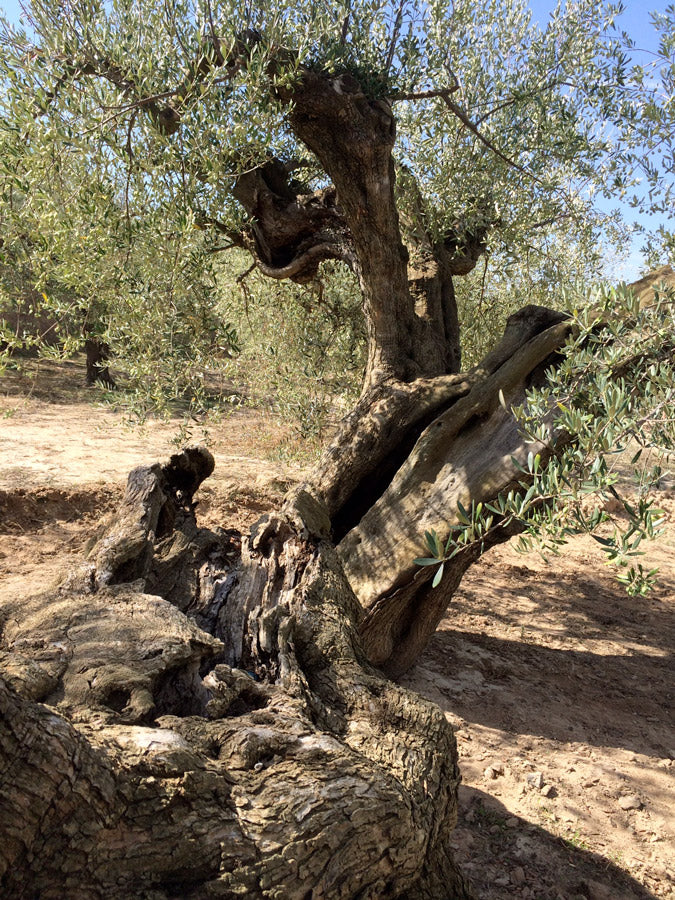Your Cart is Empty
Free Shipping on orders over 99€ - EUROPE
Free Shipping on orders over 99€ - EUROPE
Free Shipping on orders over 99€ - EUROPE

It can be said that the millenary olive trees are practically the icon that represents the entire Mediterranean region. Without a doubt, they are unique in their kind, in addition to being able to develop in very poor soils, their resistance is admirable and surprising. They can live more than two thousand years.
The olive tree is an evergreen tree with thick, glossy dark green leaves. Its flower, white and arranged in clusters, blooms in the months of April and May. The fruits, the olives, ripen during the summer months until December.

This process is carried out by these trees for years, being one of the most resistant trees in the Mediterranean and for this reason, they have resisted for years. To this day, we can see some of these olive trees that have remained in our lands for more than a thousand years, and are considered ancient olive trees.
The characteristic that has made them last so many years is their high resistance to adverse weather conditions, always within the Mediterranean climate. Since they are trees that resist very well to times of drought.

Another of the peculiarities of these thousand-year-old olive trees is the curious and amazing shapes that they form over the years. The broken trunks, of great volume and with holes are the identity symbol of the millenary olive trees.
Millenary olive trees over 4,000 years old have been found in Palestine. A place where they harvest these trees is an important part of their culture. And where the necessary knowledge for its care and harvest has been transmitted from generation to generation as a very precious asset.
It is easy to recognize one of these thousand-year-old olive trees, continually mentioned in the Bible. A tree whose crown is usually broad and leafy, ending in a thick and twisted trunk with very recurring shapes that can become a true artistic work of nature. The olive harvest is still done manually today. You simply hit the branches and their fruits fall.

Many families organize their lives around the life cycle of the ancient olive trees in this corner of the Mediterranean. For this reason, October, the month in which the olive harvest begins, is one of the most important times of the year. Parents, children, grandchildren come together to harvest millenary olive trees that have always been present in their family for different generations.
Our ancestors taught us how these trees should be cultivated, and the care that must be taken during pruning so as not to damage the olive trees. Therefore, it is essential that the olive harvest is done by hand, since doing it with manual vibrators, the olive trees could be damaged.

It should be mentioned that although the ancient olive trees are strongly rooted in the Mediterranean basin, their cultivation is currently spreading throughout the world, especially due to the increasing demand for their products. Keeping in mind that the olive tree can grow in a wide range of latitudes, between 30º to 40º from the South and North. Except at too high altitudes.
Olive trees are a great economic source. It should not be forgotten that the ancient olive trees are one of the first fruit trees that have been domesticated by man. Various basic products can be obtained from its harvest, such as olive oil, olive soap and table olives.
Olive oil is also a very effective natural remedy to relieve various heart problems, reduce blood pressure, eliminate headaches, relieve coughs, and improve any digestive problem. Although a large part of these products are sold in the locality where they are produced, they are also very well received and demanded in the international market.
In addition, it is very important to preserve the ancient olive trees that remain today. In 1956, a large number of ancient olive trees died due to a severe frost. Currently, for every 5 hectares, there is 1 thousand-year-old olive tree, and it is not easy to find more than 25 thousand-year-old olive trees on the same farm. That is why, since 2006, Law 4/2006 was drawn up in the Valencian Community with the aim of protecting these trees, being prohibited from damaging, uprooting or transplanting the olive trees.
At 9 Oliveres we have specialized in the Blanqueta variety since it is a variety born in the Comtat region, as it is a variety from which an oil with a large amount of aromas is extracted and because we have a great treasure of this variety within our farm 9 Olivers. We are lucky to have 9 thousand-year-old olive trees of the Blanqueta variety on our farm.

Each of the 9 thousand-year-old olive trees that we have on our farm is unique. The 9 thousand-year-old trees are large and formidably beautiful, but each one has its unique shape and character that they have acquired over the years, as a result of the wind, the sun, pruning and the orography of the land.
Another of the characteristics of the ancient olive trees is that the trunks are split and hollow due to the passing of the years. Like any tree, in the areas of the trunk where the sap has less passage, the wood rots and generates holes and peculiar shapes. These olive trees have lived for more than a thousand years and as a result of this biological process they have come to generate trunk partitions so large that they even look like 9 different olive trees.


